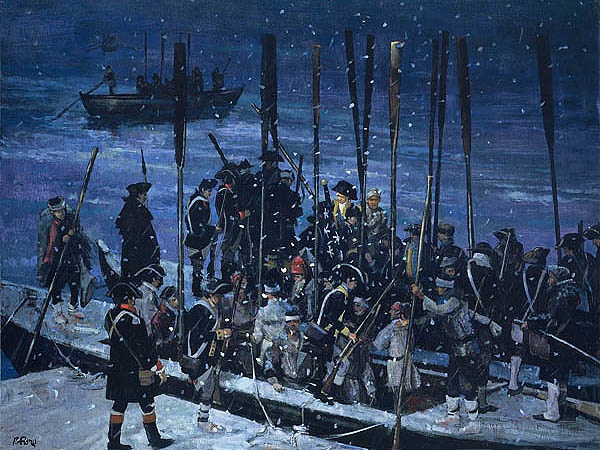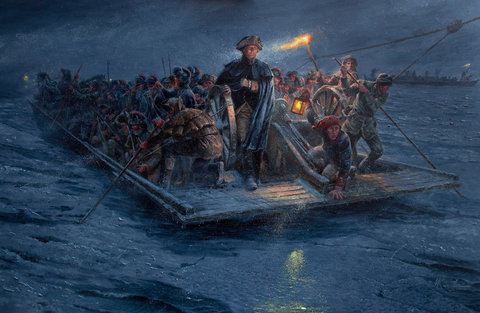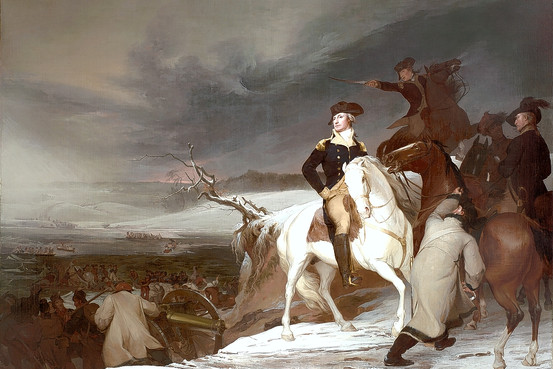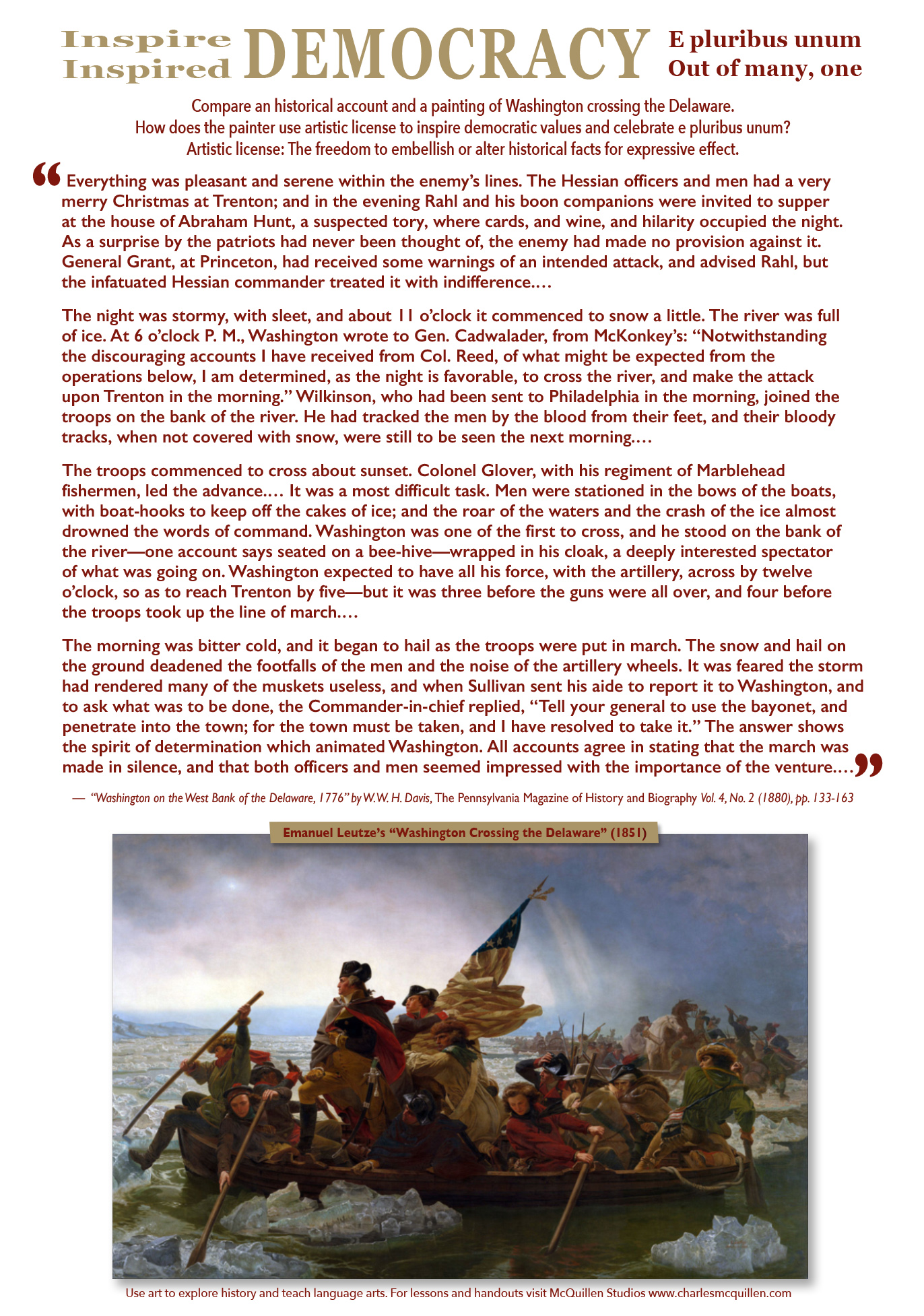Teach close reading skills, artistic license, and anagrammatic poetry with Emanuel Leutze’s Washington Crossing the Delaware.
Related Resources
- Emanuel Leutze’s Washington Crossing the Delaware is in the MET’s collection. See their website for detailed information. Select the image to magnify.
- This Look and Learn Gallery Walk explores Leutze’s life and the art and events that inspired him to paint Washington Crossing the Delaware. Special attention is given to key historical events from the American Revolution and the first national motto, E Pluribus Unum.
- This team-building game reviews key learnings from Washington Crossing the Delaware gallery walk.
- This sorting activity explores the distinct styles of art of four influential American artists from the mid 1800s — Albert Bierstadt, Eastman Johnson, Emanuel Leutze, and Worthington Whittredge.
- This writing lesson uses Washington Crossing the Delaware to teach about artistic license.
Everything was pleasant and serene within the enemy’s lines. The Hessian officers and men had a very merry Christmas at Trenton; and in the evening Rahl and his boon companions were invited to supper at the house of Abraham Hunt, a suspected tory, where cards, and wine, and hilarity occupied the night. As a surprise by the patriots had never been thought of, the enemy had made no provision against it. General Grant, at Princeton, had received some warnings of an intended attack, and advised Rahl, but the infatuated Hessian commander treated it with indifference.…
The night was stormy, with sleet, and about 11 o’clock it commenced to snow a little. The river was full of ice. At 6 o’clock P. M., Washington wrote to Gen. Cadwalader, from McKonkey’s: “Notwithstanding the discouraging accounts I have received from Col. Reed, of what might be expected from the operations below, I am determined, as the night is favorable, to cross the river, and make the attack upon Trenton in the morning.” Wilkinson, who had been sent to Philadelphia in the morning, joined the troops on the bank of the river. He had tracked the men by the blood from their feet, and their bloody tracks, when not covered with snow, were still to be seen the next morning.…
The troops commenced to cross about sunset. Colonel Glover, with his regiment of Marblehead fishermen, led the advance.… It was a most difficult task. Men were stationed in the bows of the boats, with boat-hooks to keep off the cakes of ice; and the roar of the waters and the crash of the ice almost drowned the words of command. Washington was one of the first to cross, and he stood on the bank of the river—one account says seated on a bee-hive—wrapped in his cloak, a deeply interested spectator of what was going on. Washington expected to have all his force, with the artillery, across by twelve o’clock, so as to reach Trenton by five—but it was three before the guns were all over, and four before the troops took up the line of march.…
The morning was bitter cold, and it began to hail as the troops were put in march. The snow and hail on the ground deadened the footfalls of the men and the noise of the artillery wheels. It was feared the storm had rendered many of the muskets useless, and when Sullivan sent his aide to report it to Washington, and to ask what was to be done, the Commander-in-chief replied, “Tell your general to use the bayonet, and penetrate into the town; for the town must be taken, and I have resolved to take it.” The answer shows the spirit of determination which animated Washington. All accounts agree in stating that the march was made in silence, and that both officers and men seemed impressed with the importance of the venture.…
Excerpt from “Washington on the West Bank of the Delaware, 1776” by W. W. H. Davis The Pennsylvania Magazine of History and Biography Vol. 4, No. 2 (1880), pp. 133-163
Look at Washington Crossing the Delaware. Since this is a universally recognized image ask if students have seen it before. Some may have seen the original painting, smaller reproductions, parodies, or even the image on the back of the 1999 New Jersey state quarter. Part of the discussion will involve separating the painting’s facts and dramatic embellishments. Before reading the excerpt above, tell students the title of the piece and ask what is going on in this picture? See how much they can decipher through a group discussion. Encourage students to identify the evidence that supports their reasoning. Students should likewise be encouraged to share wonderings and voice confusions. As the conversation slows, explain you are going to read an excerpt from a history magazine that describes the events that inspired this paining. Have them listen carefully and note if the historic account aligns with the painting. After reading the excerpt ask how does this new insight change your understanding of the painting?
Begin with art history
Emmanuel Leutze was born in 1816 in Germany and immigrated with his family to the United States, eventually settling in Philadelphia. He developed an interest in drawing while sitting vigil by his father’s sickbed. By the age of 14 he was painting portraits for $5. He returned to Germany when he was 20 to study art in the Dusseldorf Academy, an influential art school that emphasized Neoclassical drawing techniques, theatrical compositions, and careful attention to detail. Sentimental and anecdotal in content, these paintings tended to be painstakingly executed in a highly finished style.
In 1848 Leutze was caught up in a series of republican revolts against European monarchies, beginning in Sicily, and spreading to France, Germany, and Italy. Leutze painted Washington Crossing the Delaware to be an inspirational symbol of political reform and to spur on his countrymen. The glorification of Washington’s courage, fortitude, and perseverance, not historical accuracy was his primary goal. While the European revolts were suppressed, the painting was celebrated in Germany and was housed in the Bremen Kunsthalle, until it was destroyed by a British air raid during World War II.
Soon after creating the original painting, Leutze created two more versions for the United States. Today, one is in the White House and the other is in the Metropolitan Museum of Art. Measuring more than 12 feet high and 21 feet long, this monumental image is the largest painting in the Metropolitan Museum of Art. While some have criticized the painting as bombastic and melodramatic, Leutze’s theatrical interpretation of this pivotal moment in America’s fight for independence struck a cord with the general public and has become an enduring symbol of American patriotism.
Look like an art critic
Access the Metropolitan Museum of Art’s website to learn more about Leutze’s Washington Crossing the Delaware. Project this image for exquisite close-up detail.
Artistic License
Leutze painted Washington Crossing the Delaware to inspire his countryman to adopt America’s democratic reforms in their own government. While he was careful to include many historically accurate artifacts, he did not let authenticity get in the way of being dramatic and expressive. The freedom to depart from the facts to create an effect is called artistic license. For example, to make Washington easily recognizable, Leutze based his image on widely distributed portraits of an older Washington. To reinforce his patriotic message he also included a flag six months before it was created. To enhance the sense of drama he crammed the soldiers onto a boat that was improbably small, the low sides allowing the viewer to focus on the soldiers’ expressions and efforts. Washington is shown standing in a statuesque pose, which would have been foolhardy in an overloaded boat buffeted by a storm and a river full of ice. The following analysis considers other ways Leutze used dramatic techniques and took full advantage of his artistic license.
The Use of Light
Point out and discuss: Leutze’s greatest artistic license may be taken in his use of light. The actual crossing of the Delaware River occurred in the early morning hours in the midst of a snowstorm. By sunrise Washington had already marched his troops nine miles to the outskirts of Trenton. Yet, Leutze silhouettes Washington in the light of a breaking dawn, with a morning star shining in the upper left corner. In addition, Leutze has added a second light source that illuminates facial features that would normally be lost in the shadows. Do you think this lighting appears more natural or theatrical? How does the lighting in this painting serve Leutze’s intentions?
Turn, Talk, and Report Back (Possible answers: The lighting is more theatrical than natural. It makes the scene more dramatic. The dawning light silhouettes Washington’s profile which makes him look more heroic. The early morning shadows unify the soldiers on the boat. The breaking dawn is symbolic and suggests Washington is leading the nation out of a stormy darkness and into a new day with a bright future. The morning star that seems to guide Washington is similar to the star of Bethlehem that guided the three wise men at the original Christmas. This reinforces the morality of his cause.)
The Figures
Point out and discuss: While Leutze faithfully rendered the historical clothing and artifacts, the soldiers depicted were a carefully selected cross section of the American people. To highlight this diversity, have students point out the different types of people as you describe their regional clothing.
- There is a rower with a Scottish tam o’shanter who could represent a new immigrant (front left)
- There is a rower of African descent (front right) This could represent a Marblehead Mariner or Prince Whipple—though Whipple was in Maryland at the time
- Two figures in coonskin caps represent western frontiersmen (bow and behind Washington)
- The rower in the red shirt has androgynous features and could be a woman
- Two figures in broad-brimmed hats are dressed like farmers (back of boat)
- The figure in the center looking over the edge of the boat is General Nathanael Greene
- The rower in the stern is dressed in buckskin trousers and moccasins, representing Native American heritage
- The man holding the flag is Lt. James Monroe, Washington’s trusted scout and the future 5th President
- General Hand sits behind Monroe
Why do you think Leutze wanted to show people from different regions? Why do you think he felt this diversity more important than historical accuracy?
Turn, Talk, and Report Back (Possible answers: The boat represents the revolutionary cause and that all Americans are in it together. Everyone is shown working and sacrificing together. The diversity depicts national unity and expresses the United States’ motto E pluribus unum—out of many, one. By showing how a young country with a diverse population pulled together for the cause of a shared democratic government Leutze was trying to inspire the German people to rally together to form their own democratic government.)
The Composition and Depictions of Motion
Point out and discuss: The composition is organized around a stable upright triangle. The rail of the boat serves as the base of the triangle. The top of the flagstaff marks the apex of the triangle. The left leg of the triangle aligns the top of the flag with Washington’s face with the boat hook pushing ice out of the way. The right leg of the triangle runs from the top of the flag and aligns with the face, shoulder, and elbow of the soldier at the back of the boat. How does this composition and the depiction of motion support Leutze’s intentions?
Turn, Talk, and Report Back (Possible answers: The bunched flag flapping back in the breeze indicates the forward motion of the boat through the ice. The lines of the oars, boat hooks, and arms of the soldiers painted at various angles instill a sense of action and energy. While everyone on the boat seems to strain against the elements, including Monroe who struggles to keep the flag aloft, the towering Washington is a vision of calm resolve and stability—even though he stands on one leg in a rocking boat. As the highest figure in the boat, Washington maintains a position of honor and his alignment with the end of the flagstaff underscores his fortitude, courage, and leadership. The upright triangular composition likewise instills a sense of grounded stability and confidence. The balance and stability Washington expresses under the circumstances makes him appear even more heroic. The grounded triangular composition accentuates the moral purpose and rightness of the cause.)
Think Like an Artist
What matters more to you, factual accuracy or dramatic expression? Historical accuracy and artistic license are not an either-or proposition, rather they exist on a spectrum. As an artist you may have to decide where on that spectrum you are most comfortable.


Compare Leutze’s Washington Crossing the Delaware with the illustration Peter Fiore created for Lynne Cheney’s book When Washington Crossed the Delaware and Mort Kunstler’s painting Washington’s Crossing. These artists contend that their work is a historically accurate rendering of Washington’s crossing but these paintings show marked differences, for example note the boats. Fiore shows Washington on a Durham boat and Kunstler shows him crossing on a barge-like ferry. No matter how extensive the research and objective the findings, history is open to interpretation.


A little further down the spectrum is Thomas Sully’s Passage of the Delaware (1819). Measuring 12×17 feet, this painting is almost as big Leutze’s but Sully went to great lengths to be historically accurate, including creating landscape studies at the precise time of year and place that Washington crossed. And still further down the spectrum is George Caleb Bingham’s Washington Crossing the Delaware (1856–1871) which seems to have found as much inspiration in Leutze’s composition as it did with the historic events themselves. These showcase different ways to depict the same event. Which of these paintings do you prefer? Why? Which painting do you find more compelling? How does this reflection inform your creative process?
Life Lesson
If you are gonna go, go big. Going big is more an issue of conviction than it is of scale. In measuring 12 feet high by 20 feet wide, Washington Crossing the Delaware is a majestically large painting, but its real power comes in Leutze’s convictions in creating it. While he studied and recreated the historic artifacts shown in the painting, he didn’t let authenticity get in the way of his desire to inspire patriotic zeal. By following this vision with such clarity and purpose, Leutze created a compelling image that changed the way people view a historical event and shaped their national identity. No matter what endeavor you are undertaking, focus on your primary goal and pursue it with unbridle enthusiasm. Your passion will be contagious.
Related Videos
- Washington Crossing The Delaware Redux (3:16) is an ABC World News Now report on the historical inaccuracies in Luezte’s painting and how Mort Kunstler paints a more accurate version of the historical moment.
- The 10 Days That Changed The World, Washington’s Crossing the Delaware (14:59) uses historical reenactments, paintings, and primary source documents to describe the Delaware River crossing and the battles of Trenton and Princeton. This video places the events depicted in the painting in historical context.
- The Crossing Part 4 (14:54) is an excerpt from the movie that offers a theatrical perspective of Washington’s crossing that compliments Leutze’s “theatrical” rendering (note the use of light and shadow).
- Favorite Parodies in Art – Washington Crossing the Delaware (6:35) showcases the breadth of parodies Leutze’s painting inspired. This is a must see if students want to riff off this composition.
Integrating into Your Curriculum
Artists oftentimes use common visual strategies or signposts to alert viewers to significant details in their art. Here are some ideas for using these visual signposts to unpack a work of art. Remember, the close reading skills in art appreciation are similar to the close reading practices taught in reading.
Click on this link for a lesson and handout for teaching writers about artistic license.
Literature Links: What piece of literature would you partner with Washington Crossing the Delaware? Since Leutze uses considerable poetic license in his painting you may want to consider related poems.
- “Washington Crossing the Delaware” by David Shulman (1936) is a 14-line rhyming sonnet in which every line is an anagram of the title. See if students can add their own line. Written / Spoken
- “George Washington” by James Russell Lowell (1875) is offered in a written and spoken form
- “Paul Revere’s Ride” by Henry Wadsworth Longfellow (1860) is poem that draws on historical facts from another key event from the American Revolution
Writing Opportunity: Research writing Historical research essays could help students separate fact from fiction. Consider having students research answers to these questions. What were the Durham boats Washington’s troops actually used to cross the Delaware River? How wide was the river at the crossing? Who were some of the key historic figures involved in the crossing (James Monroe, future President; James Madison, future President; John Marshall, future Chief Justice of the Supreme Court; Alexander Hamilton, future Secretary of State; and Aaron Burr, Jr., future Vice President and killer of Alexander Hamilton in an illegal duel)? Who were the types of people who were represented in the painting and how did the American Revolution impact their lives?
The painting itself has an interesting history that merits further research. What were the revolutions in Europe that Leutze hoped to inspire with his painting? What happened to the three paintings Leutze painted? How does the painting reflect Leutze’s abolitionist leanings? How did pre-Civil War politics influence how the painting was viewed in the United States?
The Question Formulation Technique (QFT) can help turn art observations and wonderings into inquiry-based research questions that build on student insights and interests. For ideas on how to structure inquiry circle see Stefanie Harvey and Smokey Daniels Comprehension and Collaboration: Inquiry Circles for Curiosity, Engagement, and Understanding.
How would you use this painting to elaborate on one of your units of study? Please share if you have other ideas on how to teach Washington Crossing the Delaware by Emanuel Leutze as an English/language arts lesson plan.
Drag and Drop Handout JPGs
To make a handout drag and drop the jpg into a Word doc. In the Word doc open View and access the ruler. Adjust margins for optimum effect.



Comments are closed, but trackbacks and pingbacks are open.